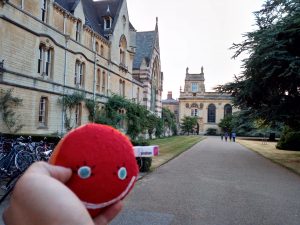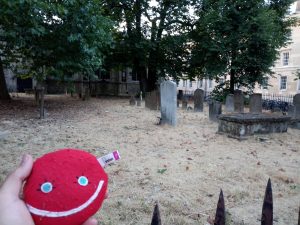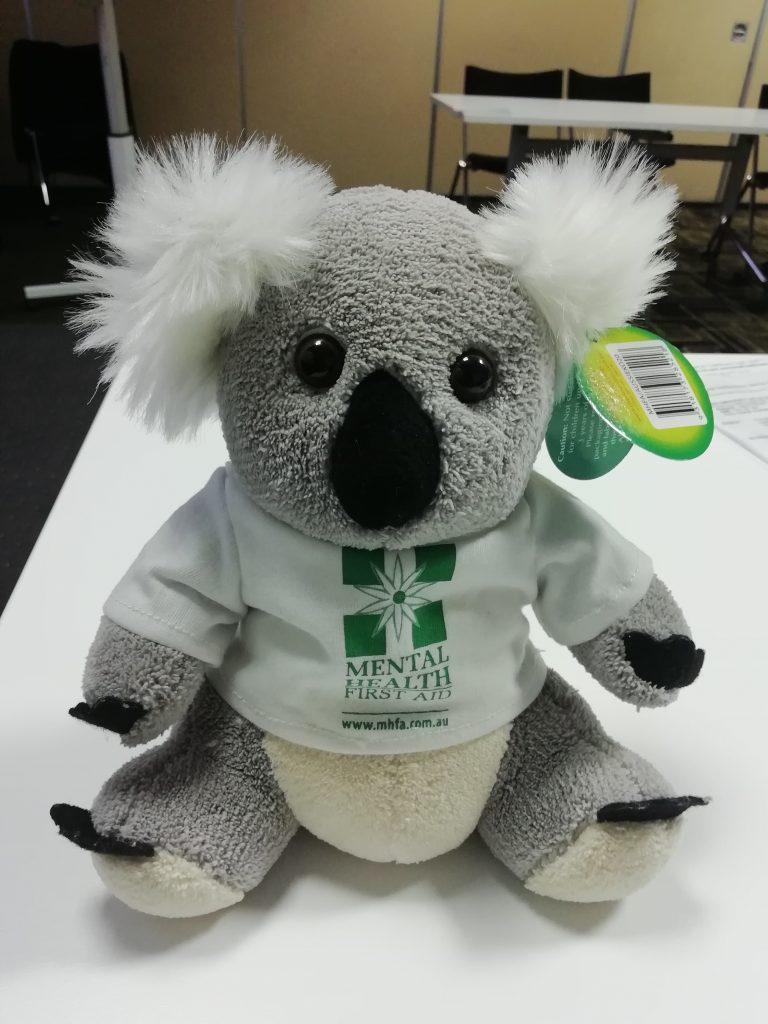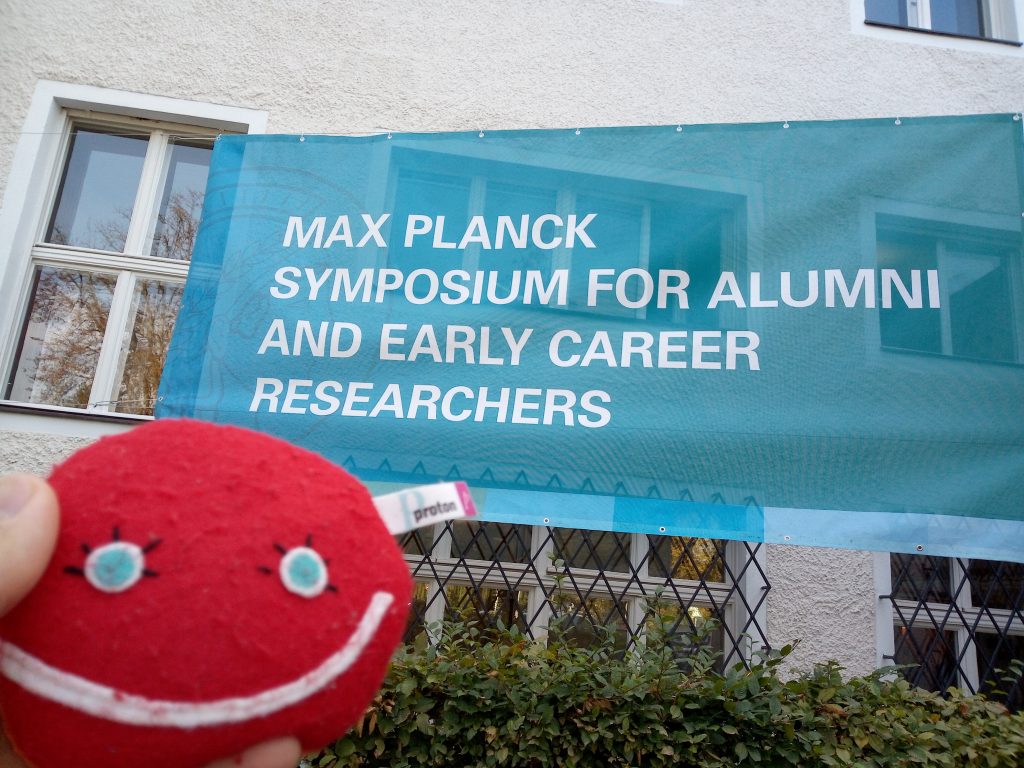For once I make room here for another mascot: Say hi to ALGEE .
So Mental Health First Aid is a thing here in Australia which is pretty cool. and ALGEE is the mascot for MHFA. I think such courses should be mandatory for any leadership position as much as normal first aid is for a driving license.
It is a two day course and covers mostly emergency intervention and knowledge of professional support structures.
Berlin

The last week of the trip I spent back in Berlin at the conference on “Stability Phenomena in Geometry and Mathematical Physics” organized by Olaf Müller. The most interesting take away were some new ideas to approach Kerr uniqueness.

Leipzig

The second stop on my trip was Leipzig. There I attended the workshop “Progress and Visions in Quantum Theory in View of Gravity” At the Max Planck for Mathematics in Science. The program put a lot of emphasis on discussions. Probably by far my most favorite conference so far. The discussions ranged from philosophical questions on the nature of time to more practical ones such as creating a quantum gravity wish list (what do we expect from a candidate theory to be taken serious) to more mundane questions of academic politics. (“Why is String Theory still a thing?”)
Monday night I went quick back to Berlin for a Science Slam.
MPSAECR, Siemensring and Digital Salon
First stop of my trip to Germany was the Max Planck Symposium for Alumni and Early Career Researchers in Berlin. There I had the pleasure to hold a workshop about science communication together with Carsten Berger and with Matyas Kovacs from Falling Walls and Kamila Staryga from X.
The second event was a panel discussion organized by the Werner-von-Siemens-Ring Foundation where I was given the chance to act as a critical commentator to the discussion. The panel was staffed prominently but unfortunately there were only few young people present and even fewer women.

To round of the week I had a chance to present my ideas for discussions at the Digital Salon organized by Dirk Helbling. I presented a sketch for internet based science publishing system that makes use of the full capabilities digital platforms have to offer.
Oxford
 On a quick trip to Oxford I had the honor of Sir Roger Penrose attending my informal seminar talk on the shadow of black holes and their degeneracies. What a magnificent scientist. His contributions to the understanding of general relativity are only
On a quick trip to Oxford I had the honor of Sir Roger Penrose attending my informal seminar talk on the shadow of black holes and their degeneracies. What a magnificent scientist. His contributions to the understanding of general relativity are only  matched by very few people in the world and many of the outstanding open problems can be traced back to him. (yes I m a little fan boy 😀 )
matched by very few people in the world and many of the outstanding open problems can be traced back to him. (yes I m a little fan boy 😀 )
Further I had the pleasure of extended discussions with Jan Sbierski on T-orthogonal trapping  and the gravitational Spin-Hall effect.
and the gravitational Spin-Hall effect.


Rome
 I got to present our results on black hole shadows at the 15. Marcel Grossmann Meeting in Rome. This years meeting was very heavy on the physics side and little mathematical relativity. It was interesting to get an update on recent progresses in observations. It was evident on the theoretical side of the event, that the recent dramatic progress in observations, particularly towards the strong field regime of gravity, enables the test of modified theories. It seems to be the biggest fashion at the moment to modify gravity in any possible way, doing some basic checks and throwing it out as a new model (possibly fitting some observations here and there a little better). The interesting points I picked up:
I got to present our results on black hole shadows at the 15. Marcel Grossmann Meeting in Rome. This years meeting was very heavy on the physics side and little mathematical relativity. It was interesting to get an update on recent progresses in observations. It was evident on the theoretical side of the event, that the recent dramatic progress in observations, particularly towards the strong field regime of gravity, enables the test of modified theories. It seems to be the biggest fashion at the moment to modify gravity in any possible way, doing some basic checks and throwing it out as a new model (possibly fitting some observations here and there a little better). The interesting points I picked up:
[latexpage] When people talk about “raw data” it is in fact often highly contaminated by $\Lambda CDM$ and constructive gravity provides an interesting link between the dynamics of the matter models and the dynamics of the geometry it couples to.
On the down side there were some questionable talks admitted to the meeting, which I think is inappropriate for one of the flagship conferences of the field of gravitation.
ETH Zurich
 On my visit back home I managed to insert a quick academic visit to my Alma Mater. Had interesting discussions with Tom Ilmanen about spacetime and entropy.
On my visit back home I managed to insert a quick academic visit to my Alma Mater. Had interesting discussions with Tom Ilmanen about spacetime and entropy.
Further I had the to talk with Thanu Padmanabhan and Hamsa Padmanabhan about their recent paper that links the value of the cosmological constant to the
amplitude of the fluctuations in the CMB. An nice explanation of their idea, accessible to laymen can be found in Nautilus. Given the claimed perfect match up of the observed values with their prediction it is certainly worth investigating further.
 The second picture shows the Drei-Grazien -Brunnen in the entrance of ETH. When I was a student there it used to be the running gag that this is probably the place at ETH with the most women. Unfortunately the numbers haven’t changed too much since then. We need to get more women in STEM!
The second picture shows the Drei-Grazien -Brunnen in the entrance of ETH. When I was a student there it used to be the running gag that this is probably the place at ETH with the most women. Unfortunately the numbers haven’t changed too much since then. We need to get more women in STEM!
Home Sweet Home
 Part 1
Part 1
Back at the Albert Einstein Institute. It was great to see everybody again. Right now it was just two days. But I will be back for more :).
Enjoy one of my favorite songs.
Part 2
So I finally defended my thesis back to back with Siyuan Ma, my academic brother and probably the person I spent the most time with during my PhD. Yay to academic twins.
Part 3
I was invited to give a Journal Club on Causal Fermion Systems. Trying to convince the quantum gravity folks that it is actually an approach worth investigating. (Moral of the story: I still have a lot to learn until I understand the formalism on a deep enough level that I can explain it in a convincing way)
March for Science, Melbourne
 Welp I finally arrived in Melbourne and as every good guest arriving in a new country, the first thing I did was going to a protest. (Yay for science)
Welp I finally arrived in Melbourne and as every good guest arriving in a new country, the first thing I did was going to a protest. (Yay for science)
The turn out was unfortunately not quite as strong as last year (but we will blame the weather given there was actually hail that day).
Institute for Astronomy, Hawaii
 My last stop on the way was at the Institute for Astronomy in Hawaii. Now that was an environment completely different from what I am used to. It was really interesting to get a glimps into what is really going on in the universe (or what we can observe there of). Good not to loose touch with physics completely when trying to solve physics related problems in mathematics.
My last stop on the way was at the Institute for Astronomy in Hawaii. Now that was an environment completely different from what I am used to. It was really interesting to get a glimps into what is really going on in the universe (or what we can observe there of). Good not to loose touch with physics completely when trying to solve physics related problems in mathematics.
I learned about the fact that when using the typical energy density of the universe to calculate the expansion rate instead of the average density one can obtain an evolution history without dark energy that closely traces a solution with dark energy where the average energy density is considered.
I had the opportunity to speak in the IfA Colloquium about the central problems in mathematical relativity and recent advances in the field.









